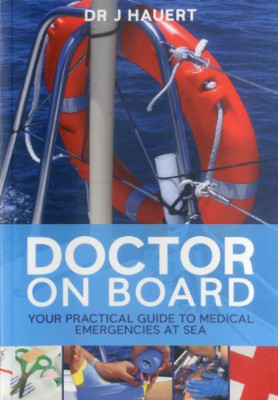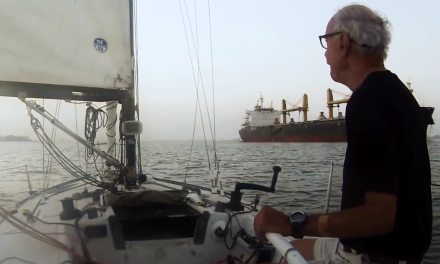 First published in German in 2008 as Medizinischer Ratgeber an Bord (translation: Medical Advice on Board), this handy guide covers medical issues that require more than the standard first aid taught by the Red Cross, Scouts, etc. Although there is also advice on treating minor issues so they don’t turn into major medical situations (e.g., hyperventilation, sunburn, etc.), the book deals mainly with serious emergencies such as heart attacks and amputations. Topics are presented in quick-to-read snippets with very easily understood step-by-step instructions, complete with illustrations in the form of color drawings or photographs. The illustrations are not of the “gross-out” variety and aim to rapidly clarify what to do rather than simply show just how bad an injury can look in real life.
First published in German in 2008 as Medizinischer Ratgeber an Bord (translation: Medical Advice on Board), this handy guide covers medical issues that require more than the standard first aid taught by the Red Cross, Scouts, etc. Although there is also advice on treating minor issues so they don’t turn into major medical situations (e.g., hyperventilation, sunburn, etc.), the book deals mainly with serious emergencies such as heart attacks and amputations. Topics are presented in quick-to-read snippets with very easily understood step-by-step instructions, complete with illustrations in the form of color drawings or photographs. The illustrations are not of the “gross-out” variety and aim to rapidly clarify what to do rather than simply show just how bad an injury can look in real life.
The book has been “Americanized” so temperatures are given in Fahrenheit as well as Centigrade and references are made to US-based resources (e.g., the advice on accidental poisoning refers the reader to the American Association of Poison Control Centers rather than some place in Europe). While many of the spellings are in British English (diarrhoea, anaemia, etc.), they are nevertheless easily understood.
Most of the situations covered apply not only to sailors far out to sea, but also to those near shore or in an inland body of water where professional help could still be quite far away (either in time or distance). Although the book covers how to request professional help, it focuses on what to do before that help arrives — invaluable in the case of a true emergency. While doctors or other medical professionals may second-guess some of the specific advice, the text repeatedly advises the on-scene caregiver to get on the radio and ask for help and request instructions from medical professionals. Additionally, it covers something people might not think about until faced with an emergency situation: how to get the victim off the boat without causing further injury to the person or damage to the boat and/or rescue craft.
One caveat about the book is that it assumes the boat has a full-blown medical kit on board that includes such devices as wound staplers and hypodermic needles. I know my boat doesn’t have a kit like that and I start feeling out of my league when faced with anything more complicated than a regular-sized adhesive bandage, but this book offers a recommended list of what to have on board and — perhaps more importantly — gives the reader the confidence to take those crucial first steps to stabilize patients and provide them the help they need until they can get professional help.
I would highly recommend this book to sailors anywhere. I consider it cheap insurance that could help to prevent a medical emergency from turning into a disaster.
Doctor on Board: A Guide to Dealing With Medical Emergencies By Jurgen Hauert (Sheridan House, 2010; 96 pages)




